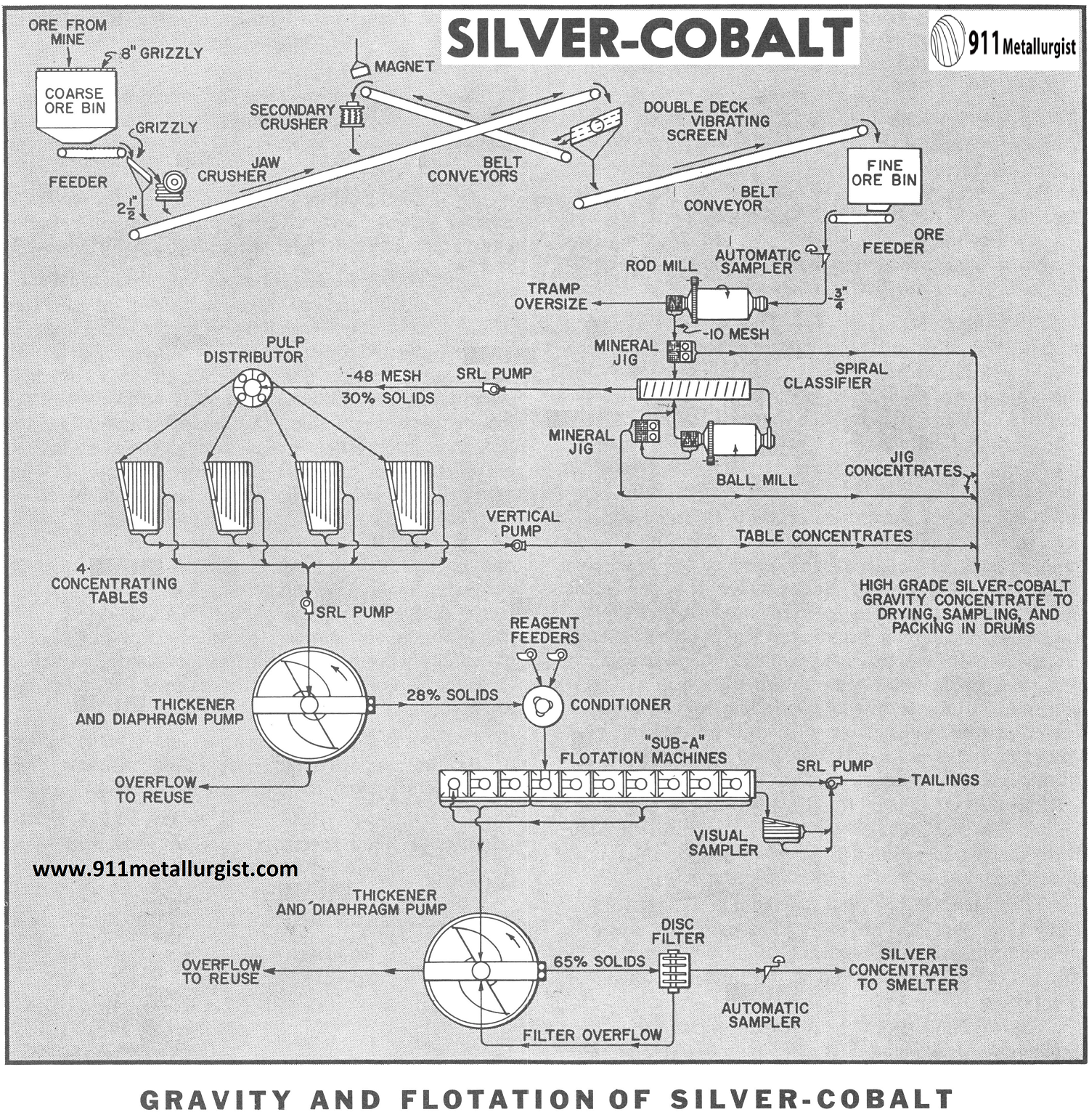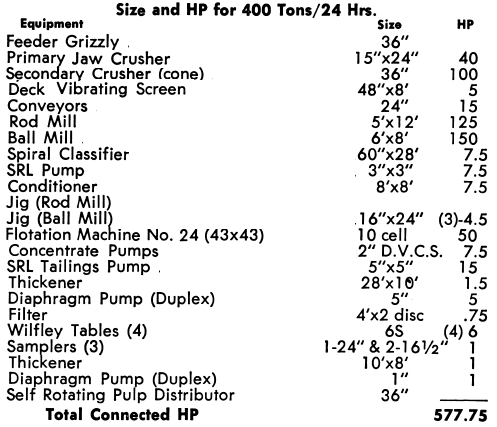Table of Contents
The treatment of complex silver cobalt ores occurring with antimony and arsenic require special metallurgical processing to produce concentrates most advantageous for smelting. Gravity concentration is used to initially recover a high percentage of the native silver and cobalt. The concentrate is marketed and payment received for these constituents. Flotation treatment of the gravity tailing recovers additional silver values for marketing at a separate smelter.
The Silver Cobalt Extraction Flowsheet
In this study, the silver occurs essentially as impure native silver together with argentite, cobaltite and other complex sulfides. The flowsheet is based on a 400 ton per day concentrator with special emphasis on “recover your mineral as soon as free.”
CRUSHING Silver Cobalt Ore
The conventional two stage crushing plant has a rated capacity in excess of 200 tons per 8 hours.
The grizzly undersize (2½”) is combined with the jaw crusher product and conveyed to a double-deck Vibrating Screen. The top deck scalps off the coarse fraction and protects the plus near mesh. All screen undersize is conveyed to the fine ore bin. The secondary crusher product discharges to the common conveyor handling the grizzly undersize and the primary jaw product.
Silver Cobalt Ore GRINDING
Two stage grinding is used. The fine ore is fed directly from the ore bin by a Belt Ore Feeder to a Rod Mill equipped with a Spiral Screen to remove tramp material. A head sample is removed from the feeder trajectory by a Automatic Sampler. The primary grind in the rod mill is approx. 10 mesh. The undersize discharged from the Rod Mill Spiral Screen is treated in a duplex Selective Mineral Jig where coarse free silver is recovered. The Mineral Jig is capable of handling an unclassified feed and is an ideal unit for the grinding circuit. The primary jig tailings flow to a Spiral Classifier.
The classifier sands discharge by gravity to the ball mill scoop box. The Ball Mill with trunnion overflow discharge is also furnished with a Spiral Screen and the screen undersize is the feed for a second Mineral Jig. Both the Rod Mill Jig and the Ball Mill Jig tailings flow by gravity to the Spiral Classifier. Two stage grinding, and gravity concentration aids recovery of values as soon as freed and precludes the possibility of loss of mineral due to overgrinding and sliming.
The jig hutch products which contain extremely high silver and cobalt values, represent approximately 65% of the total silver recovery and 80% of the cobalt recovery. Jig concentrates discharge continuously by means of a Dowsett Density Valve and are dewatered, and dried for shipment to the smelter.
GRAVITY TABLE CONCENTRATION of Silver Cobalt Minerals
The minus 48 mesh classifier overflow at 30% solids by weight is transferred by a SRL Pump to a Self Rotating Pulp Distributor which feeds the Concentrating tables. All table concentrates are combined with the jig hutch products for drying and shipment. The table middlings and tailings are pumped to a Spiral Rake Thickener. The thickener underflow at 28% solids is effectively metered to the flotation section by a Adjustable Stroke Diaphragm Pump. All reclaimed water from the thickener overflow is pumped to a constant head mill water tank. Vertical Centrifugal Sand Pumps are employed for silver-cobalt table concentrate handling.
Silver Cobalt FLOTATION Circuit
Preparatory to flotation, the thickener underflow pulp is conditioned with reagents in a Super Agitator and Conditioner. All chemical additives are metered by Reagent Feeders. The conditioned slurry flows to a cell-to-cell “Sub-A” Flotation Machine comprised of ten cells arranged as seven roughers and three cleaners. Flexibility provides that one or more of the three cleaners could be used as a recleaner depending on the mill feed.
A final tailing is discharged from the seventh rougher cell, is sampled by a Automatic Sampler, then pumped by a SRL to the tailing pond.
The rougher flotation concentrate flows by gravity to the number one or number two cell for cleaning. If recleaning is indicated the concentrates from cells Nos. 2 and 3 are returned by gravity as feed to No. 1 cell.
THICKENING AND FILTRATION
The cleaned silver concentrate is densified in a Concentrate Thickener to 65% solids. The underflow is handled by a Adjustable Stroke Diaphragm Pump and fed to a Disc Filter. The filter cake of approximately 11% moisture is dropped to the floor below where it is sampled and conveyed to a storage bin. This concentrate is shipped in bulk to the smelter.
SAMPLING
A portion of the tailing pulp from the rougher flotation circuit is removed and treated on the Visual Sampler, which consists of a ¾” Suction Pressure Diaphragm Pump to a No. 13A Concentrating Table. The flotation results and conditions are easily controlled by observing the concentrate streak on the table. This particular sampling arrangement has proven to be very effective. All wet sampling is operated on the basis of one cut every 15 minutes, and dry sampling one cut every three minutes.
PROJECTED PLANT OPERATING COSTS
It is estimated that the average direct milling costs for the above concentrator would be as tabulated below:
Grizzly and Bins……………………………………………………………….$ 1.10 per ton
Crushing and Conveying……………………………………………………..4.20 per ton
Grinding and Classification…………………………………………………5.20 per ton
Tables and Jigs…………………………………………………………………..1.90 per ton
Flotation…………………………………………………………………………..3.40 per ton
Filtering……………………………………………………………………………0.90 per ton
Drying and Handling……………………………………………………………1.11 per ton
Tailing Disposal…………………………………………………………………..0.10 per ton
Sampling and Assaying………………………………………………………..0.40 per ton
Total Operating Cost…………………………………………………………..$18.00 per ton

Source: This article is a reproduction of an excerpt of “In the Public Domain” documents held in 911Metallurgy Corp’s private library.
